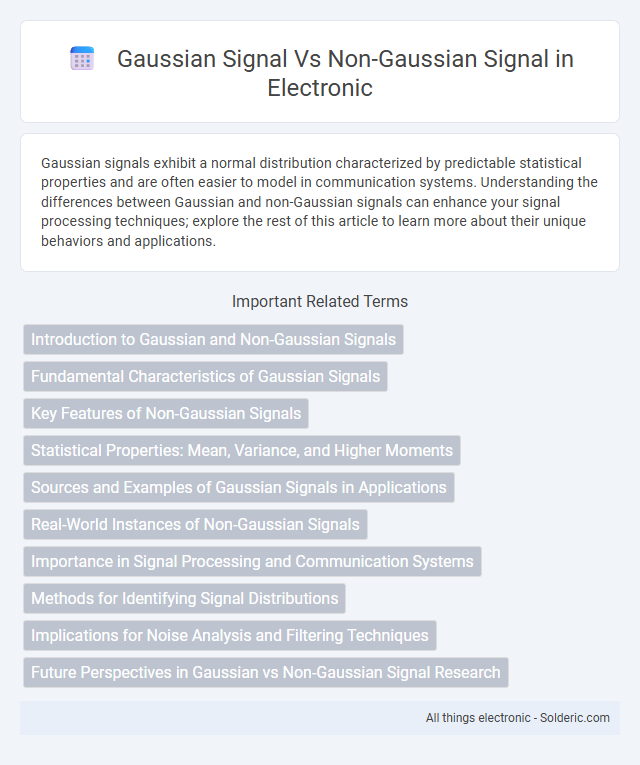Gaussian signals exhibit a normal distribution characterized by predictable statistical properties and are often easier to model in communication systems. Understanding the differences between Gaussian and non-Gaussian signals can enhance your signal processing techniques; explore the rest of this article to learn more about their unique behaviors and applications.
Comparison Table
| Feature | Gaussian Signal | Non-Gaussian Signal |
|---|---|---|
| Probability Distribution | Normal distribution (bell curve) | Does not follow normal distribution; can be skewed or heavy-tailed |
| Statistical Properties | Completely described by mean and variance | Requires higher-order statistics for full characterization |
| Noise Model | Common model for thermal noise and many natural processes | Models impulsive noise, heavy-tailed noise, or other complex behaviors |
| Independence of Moments | All moments determined by first two moments (mean, variance) | Higher moments (skewness, kurtosis) are significant |
| Signal Processing | Linear filters and optimal estimators are effective | May require nonlinear techniques or robust estimation methods |
| Applications | Communication systems, radar, speech processing | Financial modeling, bio-signals, impulsive noise environments |
Introduction to Gaussian and Non-Gaussian Signals
Gaussian signals exhibit a probability distribution characterized by a symmetric bell curve, making them predictable and mathematically tractable in signal processing and communications. Non-Gaussian signals deviate from this normal distribution, often displaying skewness, kurtosis, or multimodal characteristics that require advanced analysis techniques for accurate modeling. Understanding the distinction between Gaussian and non-Gaussian signals is crucial for designing effective filters and detectors in your signal processing applications.
Fundamental Characteristics of Gaussian Signals
Gaussian signals are characterized by their statistical properties, where every sample follows a normal distribution defined by its mean and variance. These signals exhibit predictable power spectral density and possess a symmetric probability density function, crucial for simplifying analysis in communication systems. Understanding these fundamental characteristics allows you to effectively model noise and optimize signal processing techniques in various applications.
Key Features of Non-Gaussian Signals
Non-Gaussian signals exhibit statistical properties that deviate from the normal distribution, characterized by skewness, kurtosis, and heavy tails, which reflect higher probability of extreme events. These signals often possess non-linear structures and impulsive noise, making them crucial in fields like radar, communication, and biomedical signal processing. Unlike Gaussian signals with symmetrical and predictable behavior, non-Gaussian signals require advanced modeling techniques such as higher-order statistics and non-linear filtering for accurate analysis and detection.
Statistical Properties: Mean, Variance, and Higher Moments
Gaussian signals are characterized by a symmetric probability distribution defined completely by their mean and variance, with all higher-order moments expressed in terms of these two parameters. Non-Gaussian signals exhibit distinct statistical properties where skewness and kurtosis--third and fourth moments--play significant roles in describing asymmetry and heavy-tailed behavior, respectively. The difference in higher-order moments between Gaussian and non-Gaussian signals critically impacts signal processing techniques such as filtering, detection, and estimation.
Sources and Examples of Gaussian Signals in Applications
Gaussian signals commonly arise from natural phenomena such as thermal noise in electronic circuits, radar signal reflections, and communication channel noise, modeled by a normal distribution due to the central limit theorem. Examples include white noise in audio processing, electromagnetic radiation in wireless communication, and measurement errors in sensor data. These signals serve as fundamental models in signal processing algorithms for denoising, detection, and estimation tasks across applications in telecommunications and control systems.
Real-World Instances of Non-Gaussian Signals
Non-Gaussian signals frequently arise in real-world scenarios such as financial market data, where asset returns exhibit heavy tails and skewness, deviating from Gaussian assumptions. Vocoder signals in speech processing and certain radar and sonar echoes also display non-Gaussian characteristics due to their impulsive and sparse nature. These signals challenge traditional Gaussian-based models and require specialized methods like heavy-tailed distributions or higher-order statistics for accurate analysis.
Importance in Signal Processing and Communication Systems
Gaussian signals are fundamental in signal processing and communication systems due to their statistical properties, such as having a normal distribution, which simplifies analysis and design of filters, detectors, and estimators. Non-Gaussian signals, exhibiting skewed or heavy-tailed distributions, require advanced techniques like higher-order statistics or non-linear processing to accurately model and extract useful information. Understanding whether Your signal is Gaussian or non-Gaussian directly impacts the effectiveness of noise reduction, channel modeling, and system performance optimization.
Methods for Identifying Signal Distributions
Signal distribution identification methods involve statistical tests such as the Kolmogorov-Smirnov test, Shapiro-Wilk test, and Anderson-Darling test to determine Gaussianity by comparing empirical data against theoretical Gaussian distribution models. Non-Gaussian signal detection applies higher-order statistical measures like kurtosis and skewness, alongside techniques such as Independent Component Analysis (ICA) and cumulant-based methods to capture deviations from normality. Time-frequency domain analysis and machine learning algorithms also enhance classification accuracy by characterizing signal properties beyond traditional Gaussian assumptions.
Implications for Noise Analysis and Filtering Techniques
Gaussian signals exhibit statistical properties defined by a normal distribution, allowing noise analysis and filtering techniques like Kalman filters to perform optimally due to predictable mean and variance characteristics. Non-Gaussian signals, characterized by heavier tails or skewed distributions, challenge traditional noise models, necessitating advanced methods such as particle filters or robust statistical approaches to accurately handle impulsive or non-linear noise effects. Understanding whether your signal follows a Gaussian or non-Gaussian distribution is crucial for selecting appropriate filtering techniques that ensure more reliable noise reduction and signal recovery.
Future Perspectives in Gaussian vs Non-Gaussian Signal Research
Future perspectives in Gaussian vs non-Gaussian signal research emphasize advanced machine learning techniques to improve signal classification and processing accuracy. Emerging applications in wireless communications and radar systems leverage non-Gaussian models for enhanced noise resilience and interference detection. Progress in stochastic modeling and higher-order statistics promises breakthroughs in effectively distinguishing and utilizing complex signal environments.
Gaussian signal vs non-Gaussian signal Infographic

 solderic.com
solderic.com